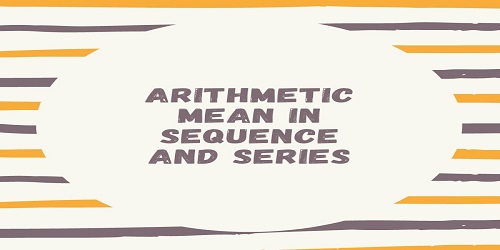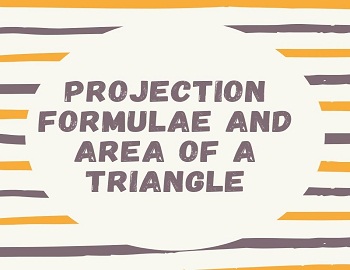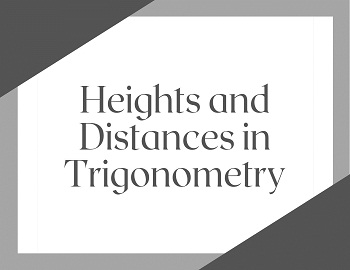Arithmetic Mean:
If a and b are the two numbers such that a, A1, A2, A3, ……., An, b are in arithmetic progression then A1, A2, A3, ……., An be the ‘n’ arithmetic means between a and b.
Single Arithmetic Mean Between a and b:
If a and b be the two numbers then the arithmetic mean between a and b is-
| A = (a + b)/2 |
Insertion of n Arithmetic Mean between a and b:
Let A1, A2, A3, ……., An be the n arithmetic means between a and b.
∴ a, A1, A2, A3, ……., An, b are in arithmetic progression.
| Now, b = an + 2 ⇒ b = a + (n + 2 – 1) d ⇒ b = a + (n + 1) d ⇒ d = (b – a)/(n + 1) ∴ A1 = a + d = IInd term of arithmetic progression A2 = a + 2d = IIIrd term of arithmetic progression A3 = a + 3d = IVth term of arithmetic progression ………….. An = a + nd = (n + 1)th term of arithmetic progression |
| Example- Prove that the sum of n arithmetic means between the two numbers is equal to n times the single arithmetic mean between the two numbers. Solution- Let a and b be the two numbers and let A1, A2, A3, ……., An be the n arithmetic means between a and b. ∴ a, A1, A2, ……., An, b are in arithmetic progression. Now, A1 + A2 + ……… + An = n/2 [A1 + An] = n/2 [a + d + a + nd] = n/2 [a + (a + (n + 1) d)] = n/2 [a + b] = n [(a + b)/2] = n (single arithmetic mean between the numbers) |
| Example- Insert 4 arithmetic means between 5 and 20. Solution- Let A1, A2, A3, ……., An be the 4 arithmetic means between 5 and 20. ∴ 5, A1, A2, A3, A4, 20 are in arithmetic progression. Here d = (20 -5)/(4 + 1) = 3 ∴ A1 = a + d = 5 + 3 = 8 A2 = a + 2d = 5 + 2 (3) = 11 A3 = a + 3d = 5 + 3 (3) = 14 A4 = a + 4d = 5 + 4 (3) = 17 ∴ 4 arithmetic means between 5 and 20 are 8, 11, 14, 17. |
| Example- There are m arithmetic means between 7 and 85 such that (m – 3)th mean: mth mean is as 11 : 24. Find the value of m. Solution- Here, a = 7, b = 85 ∴ d = (b – a)/(m + 1) = (85 – 7)/(m + 1) = 78/(m + 1) Now, Am-3/Am = 11/24 ⇒ [a + (m – 3) d]/(a + md) = 11/24 ⇒ 24a + 24 (m – 3) d = 11a + 11md ⇒ 13a = 11md – 24 (m – 3) d ⇒ 13a = [11m – 24 (m – 3)] d ⇒ 13a = (11m -24m +72) [78/(m + 1)] ⇒ 13 (7) = (-13m + 72) [78/(m + 1)] ⇒ 7 (m + 1) = (-13m + 72) 6 ⇒ 7m + 7 = -78m + 432 ⇒ 85m = 425 ⇒ m = 425/85 = 5 |
| Example- Find the value of n such that (an + bn)/(an-1 + bn-1) may be the A.M. between the two distinct numbers a and b. Solution- Arithmetic Mean between a and b is (a +b)/2. Also for some value of n, (an + bn)/(an-1 + bn-1) is the A.M. of a and b. ∴ (an + bn)/(an-1 + bn-1) = (a +b)/2 ⇒ 2 (an + bn) = (a +b) (an-1 + bn-1) ⇒ 2an + 2 bn = an + abn-1 + ban-1 + bn ⇒ an + bn = abn-1 + ban-1 ⇒ an – ban-1 = abn-1 – bn ⇒ an-1 (a – b) = bn-1 (a – b) ⇒ an-1 = bn-1 ⇒ an-1/bn-1 = 1 ⇒ (a/b)n-1 = (a/b)0 ⇒ n – 1 = 0 ⇒ n = 1 |
| Example- There are m arithmetic means between 14 and 38. If the ratio of the second and the lat means be as 4 : 7, determine the value of m. Solution- Here a = 14, b = 38 ∴ d = (b – a)/(m + 1) = (38 – 14)/(m + 1) = 24/(m + 1) Now, A2/Am = 4/7 ⇒ (a + 2d)/(a + md) = 4/7 ⇒ 7a + 14d = 4a + 4md ⇒ 3a = (4m – 14) d ⇒ 3a = (4m – 14) [24/(m + 1)] ⇒ 3 (14) = 2 (2m – 7) (24)/(m + 1) ⇒ 7 = 8 (2m – 7)/(m + 1) ⇒ 7m + 7 = 16m – 56 ⇒ 9m = 63 ⇒ m = 7 |
| Example- If A is the arithmetic mean between a and b, prove that (i) (A – a)2 + (A – b)2 = (1/2) (a – b)2 (ii) 4 (a – A) (A – b) = (a – b)2 Solution- A is the arithmetic mean between a and b. ∴ A = (a +b)/2 (i) (A – a)2 + (A – b)2 = [(a + b)/2 – a]2 + [(a + b)/2 – b]2 = [(b – a)/2]2 + [(a – b)/2]2 = 2 [(a – b)/2]2 = 2 (a – b)2/4 = (1/2) (a – b)2 (ii) 4 (a – A) (A – b) = 4 [a – (a + b)/2] [(a + b)/2 – b] = 4 [(2a – a – b)/2] [(a + b – 2b/2] = (a – b) (a – b) = (a – b)2 |









Comments (No)